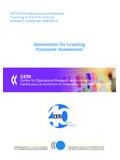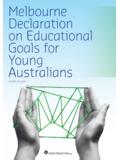Transcription of National curriculum assessments Key stage 1 - GOV.UK
1 National curriculum assessmentsKey stage 1 Pre-key stage 1: pupils working below the National curriculum assessment standardTeacher assessment frameworkFor use from the 2020/21 academic year onwards[BLANK PAGE]This page is intentionally 3 of 13 Changes to statutory assessment arrangements for pupils working below the standard of National curriculum assessments In 2015, the government established an independent review of statutory assessment arrangements for pupils in primary school who are working below the standard of National curriculum assessments , led by Diane Rochford. We conducted a public consultation on the Rochford Review s recommendations between March and June 2017, and published our response to the consultation in September 2017.
2 Pupils engaged in subject-specific study The government consultation on the Rochford Review found broad support to extend the interim pre-key stage standards to include all pupils working below the standard of National curriculum assessments engaged in subject-specific study. The Standards and Testing Agency conducted a review of the interim pre-key stage standards, working with teachers and other education experts, before publishing the final versions presented in this document. We have revised the pupil can statements to ensure that they appropriately represent the key aspects of each subject, allow for progression towards the National curriculum and better reflect classroom practice. These standards must be used for statutory assessment at the end of key stage 1 for pupils working below the standard of National curriculum assessments engaged in subject-specific study.
3 These standards were first used from the 2018/19 academic year. Pupils not yet engaged in subject-specific study The government response to the public consultation on the Rochford Review recommendations set out the plans for the Review s recommended approach to statutory assessment for those pupils not yet engaged in subject-specific study. Following a pilot using the 7 aspects of engagement, the engagement model was developed with the support of an expert group involving members of the Rochford Review and using the evidence from an evaluation of the 7 aspects carried out in 2018. The engagement model was published in March 2020 and was intended to become statutory from September 2020. Due to the disruption caused by Covid-19, t he 2020/21 academic year will be a transitionary year (subject to the necessary legislation being made) where schools will have the time to prepare for, and start embedding, the engagement model.
4 Summary of changes between 2020/21 and 2021/22 A flexible approach will apply for the submission of teacher assessment outcomes in the 2020/21 academic year only. Schools that have used the engagement model should report which pupils have been assessed and s chools that need more time to implement the engagement model can report their teacher assessment o utcomes against P scales 1 to 4, for one final year. 2020/21 2021/22 Subject-specific study Final pre-key stage 1 standards Standard 4 Standard 3 Standard 2 Standard 1 Final pre-key stage 1 standards Standard 4 Standard 3 Standard 2 Standard 1 Not subject-specific study P scales 1 to 4, or engagement model Engagement model Page 4 of 13 Comparability over time Schools, and those reviewing school performance, should note that judgements made against these pre-key stage standards (since 2018/19) will not be directly comparable to those made up to 2017/18 against the interim pre-key stage standards and P scales.
5 Page 5 of 13 Guidance for teachers Main principles The pre-key stage standards are provided for the statutory assessment of pupils engaged in subject-specific study who are working below the overall standard of the National curriculum tests and teacher assessment frameworks. If a pupil is working below the standard of these pre-key stage standards, their outcome should be reported using the engagement model or the relevant P scales in the 2020/21 academic year only. The engagement model must be used from the 2021/22 academic year. The pre-key stage standards must be used to make statutory teacher assessment judgements for pupils who have reached the end of year 2, when an outcome must be reported for school accountability purposes, but who have not completed the relevant National curriculum programme of study.
6 The pre-key stage standards focus on certain key aspects of English reading, English writing and mathematics for the specific purpose of statutory end-of-key stage assessment . While the standards are designed to capture attainment in t hese subjects, individual pupils will demonstrate achievement in different aspects of their education and this should also be reported to parents. Teachers should recognise the progress of individual pupils, setting targets that refer to agreed outcomes within the Special Educational Needs and Disability Code of Practice 2015, where appropriate. Teachers should base their judgements on a broad range of evidence, which will come from day-to-day work in the classroom. This can be drawn from work in subjects other than the one being assessed, although a pupil s work in that subject alone may provide sufficient evidence to support the judgement.
7 Teachers may also consider a single example of a pupil s work to provide sufficient evidence for multiple statements. Teachers should be confident that pupils have met the standard(s) preceding the one at which they judge them to be working. However, they are not required to have specific evidence for that judgement. A pupil s work which demonstrates a standard is met is sufficient to show that they are working above the preceding standards. Each subject framework has four standards of attainment containing pupil can statements upon which teachers will base their judgements. Teachers should follow the specific guidance for each subject. The standards are not a formative assessment tool: they should not be used to track progress throughout the key stage or to guide individual programmes of study, classroom practice or methodology.
8 Teachers should assess individual pieces of pupils work in line with their school s own, more detailed, assessment policy and not against these standards. Those reviewing school performance, including Ofsted inspectors, would not expect them to be used for anything other than summative assessment at the end of the key stage . The pre-key stage standards may also be useful for teachers to refer to for pupils of all ages, including those attending secondary school, but there is no statutory requirement to do so. Page 6 of 13 Qualifiers and examples Some of the statements within the standards contain qualifiers ( some , many and most ) to indicate the extent to which pupils should demonstrate the knowledge or skill required.
9 Where qualifiers are used, they have consistent meaning: most indicates that the statement is generally met with only occasional errors; many indicates that the statement is met frequently but not yet consistently; and some indicates that the skill/knowledge is starting to be acquired and is demonstrated correctly on occasion, but is not yet consistent or frequent. Some of the s tatements contain examples. These do not dictate the evidence required, but show only how that statement might be met. assessment of pupils with disabilities All schools are required to make reasonable adjustments for pupils with disabilities. Disability is defined in the Equality Act 2010 as a physical or mental impairment which has a substantial and long-term adverse effect on their ability to carry out normal day-to-day activities.
10 When teachers assess pupils against the pupil can statements, they should base their judgements on what disabled pupils can do when those reasonable adjustments are in place (for example, reducing anxiety by providing a quiet study space, or allowing more time to process instructions). If a pupil has a disability that prevents them from demonstrating attainment in the way described in a pupil can statement, their individual method of communication or study is applicable (for example, using a visual phonics system for a pupil with a hearing impairment, using a brailler or a computer with access technology for a pupil with vision impairment who writes in braille, or using a word processor or scribe for a pupil who is physically unable to write).
















